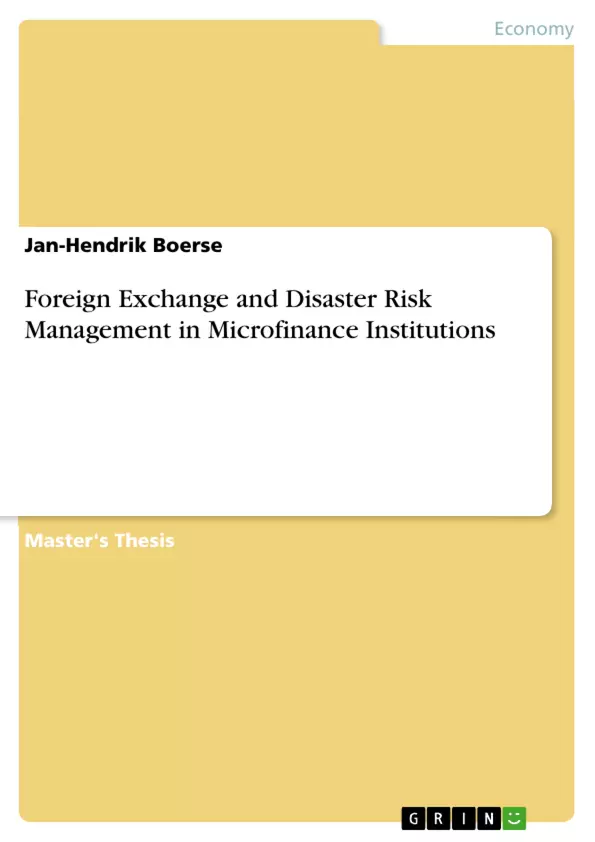Microfinance Institutions (MFI) have left the role of altruistic instruments for donor-assistance and turned into profitable financial institutions and interesting investment opportunities for international financial investors.
However, well-intentioned investments can dramatically increase a MFIs risk exposure and institutions without proper risk management can easily be forced into closure in the aftermath of environmental or economical distress.
Moreover MFIs operate predominant in developing countries counting for 94% of all natural disasters worldwide and the vulnerability of their clients is exorbitant high due to their establishment in simple accommodation facilities and the strong dependence on agricultural business.
Foreign exchange and disaster risks are considered to be two of the most jeopardising threats for MFIs characterised by close interrelations and ignored by the majority of institutions, investors and credit users.
This work compiles a holistic risk management approach starting with the sound assessment of foreign exchange and disaster risks with the aid of modern tools such as hazard modelling and the value-at-risk model.
Based on the institutions particular risk-bearing capacity different strategies to minimise and transfer these risks have been evaluated. More than twenty methods from operational hedges to innovative instruments like indexed weather derivatives or currency and catastrophe swaps are investigated concerning their availability, applicability, effectiveness and efficiency in the microfinance context.
Furthermore this work seeks to design the strategies in a way that overcomes particular obstacles like the Samaritans dilemma to create sustainable security along with rising self responsibility. Consequently the employed instruments have been modified regarding their trigger concepts and payment schemes.
As the implementation of many useful tools would be hampered due to the MFIs size, pooling alternatives between MFIs have been analysed as well as cooperation models with international companies or public private partnerships.
In interviews with global experts from MunichRe, SwissRe and FMO specific issues have been discussed and the feasibility of the strategies could be affirmed.
This work can provide useful guidance for risk managers, investors, donors and all persons that are directly or indirectly responsible for the sustainable development of one or several microfinance institutions.
Inhaltsverzeichnis (Table of Contents)
- INTRODUCTION
- ECONOMICS OF MICROFINANCE INSTITUTIONS
- OVERVIEW ABOUT THE FOLLOWING CHAPTERS
- RISK IDENTIFICATION AND ASSESSMENT
- OVERALL RISK MAPPING IN MFIS
- ANALYSIS OF DISASTER-RELATED RISKS
- INTRODUCTION TO DISASTER RISKS
- DISASTER-RELATED RISK MAP
- ASSESSMENT OF DISASTER-RELATED RISKS
- ANALYSIS OF FX-RELATED RISKS
- INTRODUCTION TO FX RISK
- FX-RELATED RISK MAP
- ASSESSMENT OF THE RISKS IDENTIFIED
- EXCHANGE RATE SYSTEMS AND DOLLARIZATION
- MOST COMMON TREATMENT FOR FX AND DISASTER RISK
- DISASTER RISK MANAGEMENT
- INSTITUTIONAL DISASTER PREPAREDNESS
- TRIGGER CONCEPTS AND PREREQUISITES FOR THE RISK TRANSFER
- EVALUATION OF EXISTING FINANCIAL INSTRUMENTS
- CATASTROPHE BONDS
- WEATHER DERIVATIVES
- CONTINGENT CAPITAL / CONTINGENT CREDIT
- TACKLING DISASTER RISK ON HIGHER OR LOWER LEVELS
- DISASTER-MICROINSURANCE
- DISASTER LOAN FUNDS
- PUBLIC-PRIVATE-PARTNERSHIPS
- FOREIGN EXCHANGE RISK MANAGEMENT
- SUSTAINABLE RISK ACCEPTANCE
- RISK AVOIDANCE STRATEGIES
- RISK MITIGATION STRATEGIES
- CURRENT PRACTICES: OPERATIONAL HEDGES
- EVALUATION OF FINANCIAL INSTRUMENTS
- INNOVATIVE CONCEPTS
Zielsetzung und Themenschwerpunkte (Objectives and Key Themes)
The main objective of this work is to analyze the foreign exchange and disaster risk management in microfinance institutions. It aims to provide a comprehensive overview of the challenges faced by these institutions in managing these risks, particularly in developing countries.- The economics of microfinance institutions and their role in economic development.
- Risk identification and assessment, including disaster-related and foreign exchange risks.
- Disaster risk management strategies, including institutional preparedness, financial instruments, and public-private partnerships.
- Foreign exchange risk management strategies, including risk acceptance, avoidance, and mitigation techniques.
- Innovative concepts in managing foreign exchange and disaster risks in microfinance institutions.
Zusammenfassung der Kapitel (Chapter Summaries)
- The introduction provides an overview of the economics of microfinance institutions, emphasizing their importance in providing financial services to low-income populations. It also outlines the structure of the following chapters.
- Chapter 2 focuses on risk identification and assessment. It examines various risks faced by microfinance institutions, including disaster-related risks and foreign exchange risks. The chapter analyzes the characteristics of these risks and provides frameworks for their assessment.
- Chapter 3 delves into disaster risk management, exploring strategies for mitigating and responding to disaster-related risks. It discusses institutional preparedness, financial instruments such as catastrophe bonds and weather derivatives, and the role of public-private partnerships.
- Chapter 4 examines foreign exchange risk management in microfinance institutions. It explores different strategies, including risk acceptance, avoidance, and mitigation techniques. The chapter also evaluates various financial instruments and innovative concepts for managing FX risk.
Schlüsselwörter (Keywords)
This work focuses on the challenges of managing foreign exchange and disaster risks within microfinance institutions. The core concepts explored include risk assessment, risk mitigation, disaster preparedness, financial instruments, exchange rate systems, and innovative solutions. The specific examples of these concepts include disaster-microinsurance, disaster loan funds, catastrophe bonds, and weather derivatives.- Quote paper
- Diplom-Betriebswirt Jan-Hendrik Boerse (Author), 2008, Foreign Exchange and Disaster Risk Management in Microfinance Institutions, Munich, GRIN Verlag, https://www.grin.com/document/115636



